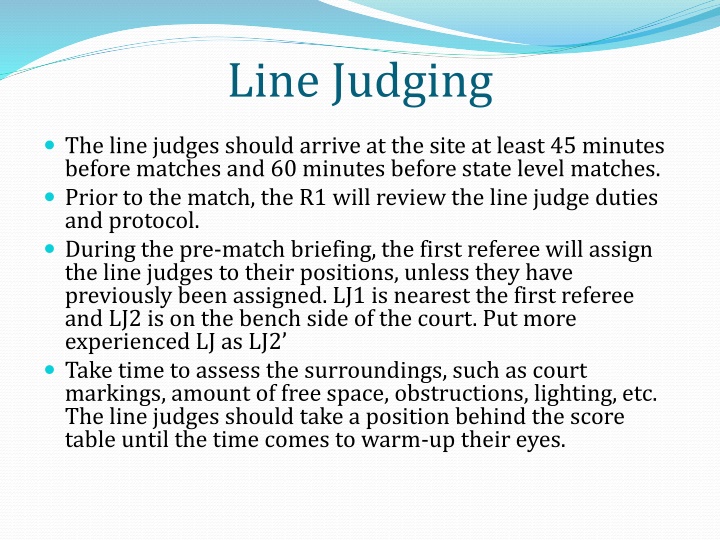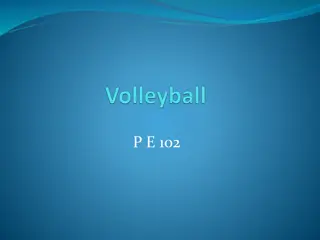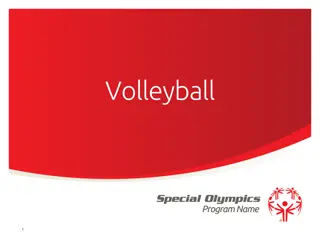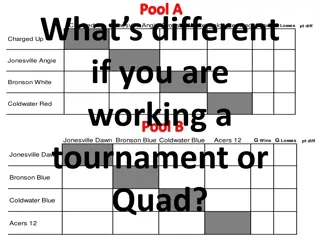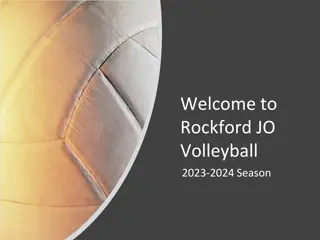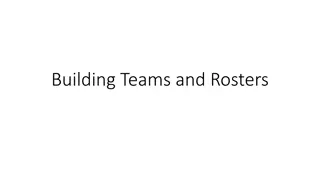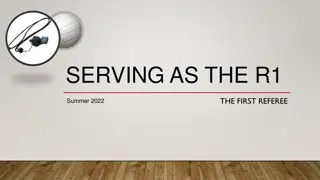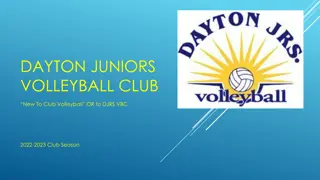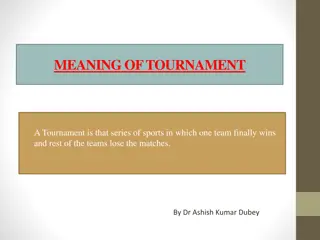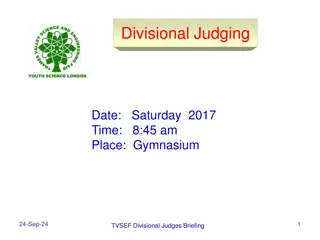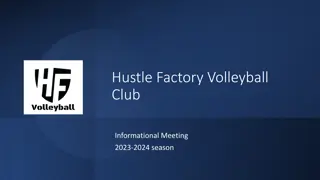Guide to Line Judging in Volleyball Tournaments
Learn the essential duties and protocols of a line judge in volleyball tournaments, from arriving early to signaling faults confidently. Find out about pre-match briefings, warm-up preparations, and handling timeouts effectively. Explore tips for positioning, signaling, and staying focused during gameplay to enhance your line judging skills.
Download Presentation

Please find below an Image/Link to download the presentation.
The content on the website is provided AS IS for your information and personal use only. It may not be sold, licensed, or shared on other websites without obtaining consent from the author.If you encounter any issues during the download, it is possible that the publisher has removed the file from their server.
You are allowed to download the files provided on this website for personal or commercial use, subject to the condition that they are used lawfully. All files are the property of their respective owners.
The content on the website is provided AS IS for your information and personal use only. It may not be sold, licensed, or shared on other websites without obtaining consent from the author.
E N D
Presentation Transcript
Line Judging The line judges should arrive at the site at least 45 minutes before matches and 60 minutes before state level matches. Prior to the match, the R1 will review the line judge duties and protocol. During the pre-match briefing, the first referee will assign the line judges to their positions, unless they have previously been assigned. LJ1 is nearest the first referee and LJ2 is on the bench side of the court. Put more experienced LJ as LJ2 Take time to assess the surroundings, such as court markings, amount of free space, obstructions, lighting, etc. The line judges should take a position behind the score table until the time comes to warm-up their eyes.
Line Judging - Warmups The team pre-match warm-up period gives line judges the chance to prepare mentally and physically for the match. While the teams warm up with attack hits, take a position (without a flag) on your assigned corner of the court, but be prepared to move to the end line extended so you do not hinder players or coaches. This preparation provides the opportunity to become familiar with player tendencies, court markings, lighting, and the speed and height at which the match will be played. Line judges should stay long enough to watch both teams (10-2). Line judges should stay on their respective corners for the same amount of time during the warm-up period.
Announcements and National Anthem All 4 officials on the side opposite of the scorer s table (except for James River). LJ 1 take their flag with them and put it on the ref stand. After R1 blows the whistle to take the court, R2 and LJ2 make it back across the court. The marks the spot for line-up checks. Move to position when R2 throws the ball to the server. LJ1/R1 R2/ LJ2
Some LJ Basics Line Judges will take charge of the ball during time outs. Signaling When a fault occurs in your area of responsibility, use these basic mechanics: Make the call with a crisp, confident signal, affirming the decision in your own mind. Bring your feet together, stand upright, and hold the signal as you make eye contact with the first referee. Maintain the signal until the first referee awards the point, then lower your flag (without a snap ) and return to your relaxed, ready position. If the first referee overrules your call, quickly lower your flag and prepare for the next rally. Get out of the way of oncoming player(s) When a player comes near you to make a play, never turn your back and run, instead backpedal while keeping your eyes on the ball and player.
A Picture Tells a 1000 Words Keep a close eye at the top of the hands for touches at the net. Transition to a Low Ready Position to get a good view as ball approaches the line. Be prepared to move by anticipating the play.
*As the play develops, focus on the blockers fingertips as the ball is being attacked. When you see a touch off of a player on your side of the court, be prepared to signal immediately if the ball then lands out of bounds on the same side of the net.
A touch is called when a player contacts the ball during a block, or the first, second, or third team hit, and then the ball lands out of bounds or contacts anything that causes it to become out of play on that team s side of the net. If the ball is hit into the net and/or opposing blockers and then lands out of bounds on the attacking team s side of the net, signal out. The first referee will routinely look at both line judges after a ball goes out of bounds to see if either one saw a touch, which is good teamwork and is not an attempt to influence your call. If you see a touch, signal it immediately, clearly, and decisively. If you do not, make eye contact with the first referee even though you do not signal. Either line judge can call a touch by either team anywhere in the playing area. However, do not signal a touch just because the other line judge does. Only signal touches you actually see.
What part of the court do I Call? On calls near your line Only Call Your Lines for in vs out. LJ1 Signal OUT LJ2 Signal IN
What else do I Call? Touches on either side of the court. Outside the antenna on either side of the court. Ball down on your side of the court. Don t give any signals for serve into the net, ball going under the net or the ball hitting the R1 LJ1 LJ2
Server in the Red Zone Player serving from the Red Zone Move away from sideline 1-2 steps Move back into position quickly
Time Out Protocol During a timeout, both line judges go to the intersection of the attack line and the sideline on the first referee s side of the court. To move to that position, both line judges quickly roll their flags, and LJ1 waits as LJ2 walks along the end line. As LJ2 turns the corner with a natural gait, both line judges walk up the sideline to the timeout position at the intersection of the sideline and the attack line. LJ1 LJ2
End of Time Out Protocol The Line Judges return the same way when: Both teams break from their huddle When the R2 blows whistle at 15 seconds remaining in the timeout (make eye contact before you leave) LJ1 LJ2
End of Set Protocol Get the ball! Similar process as timeout. If teams switch sides, wait. Eye contact and both come across the court at the same time. Take a seat in pre-arranged area. Head back to starting position at 45 seconds. If there is a deciding set, stay at timeout position until after the toss. LJ1 LJ2
More LJ Basics FOLLOW THE PROTOCOLS!! A good LJ makes the R1 and R2 Jobs easier. Line Judges need to MOVE to Get A Better View. Don t be a statue. Touches, touches and more touches. Maintain a professional demeanor before, during and after a match. Watch training videos and review signals prior. Effort goes a long way. Avoid overly familiar contact with spectators, players or coaches throughout the event. If there is a pro-longed injury, follow the time out protocol. OVER RULES Will Happen It Is Not Personal R1 may have seen it differently LJs are only providing information, it s always the R1 s Call If it s close, go with the LJ.
